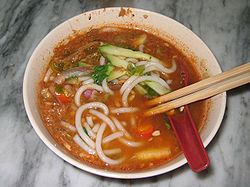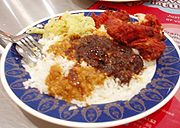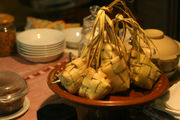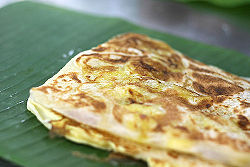
Laksa
Laksa is a popular spicy noodle soup from Peranakan culture also known as Baba and Nyonya, which is a merger of Chinese and Malay elements found in Singapore, Indonesia and Malaysia.
Origin
The origin of the name "laksa" is unclear. One theory[1] traces it back to Hindi/Persian lakhshah, referring to a type of vermicelli. It has also been suggested[2] that "laksa" may also be derived from the Chinese word "la sha" (辣沙; pronounced "latsa" in Cantonese), meaning "spicy sand" due to the ground dried prawns which makes the gravy taste extremely sandy. The last theory[3] is that the name laksa is derived from the similar sounding word "dirty" in Hokkien due to its appearance.
Types of laksa
The term "laksa" is used generally to describe two different basic types of noodle soup dishes: curry laksa and asam laksa. Curry laksa is a coconut curry soup with noodles, while asam laksa is a sour fish soup with noodles. Usually, thick rice noodles also known as laksa noodles are preferred, although thin rice vermicelli (bee hoon or mee hoon) is also common and some variants use other types.

Nasi kandar
Famous Malaysian food, Nasi Kandar.
Nasi Kandar is a popular northern Malaysian dish, which originates from Penang. It is a meal of steamed rice which can be plain or mildly flavored, and served with a variety of curries and side dishes. The word Nasi Kandar, came about from a time when nasi [rice] hawkers or vendors would kandar [balance] a pole on the shoulder with two huge containers of rice meals. The name has remained and today the word Nasi Kandar is seen on most Tamil Muslim or "Malaysian Mamak" restaurants and Indian-Muslim stall meals. The rice for a nasi kandar dish is often placed in a wooden container about three feet high, giving it a distinctive aroma. The rice is accompanied by side dishes such as fried chicken, curried spleen, cubed beef, fish roe, fried prawns or fried squid. The vegetable dish would usually be brinjal (aubergine), okra (lady fingers or "bendi") or bitter gourd. A mixture of curry sauces is poured on the rice. This is called 'banjir' (flooding) and imparts a diverse taste to the rice.Traditionally, nasi kandar is always served with its side dishes on a single plate. Nowadays, small melamine bowls are used for the side dishes. Nevertheless, the curry sauce mix is always poured directly onto the rice.The most famous nasi kandar stalls in Penang are Kassim Restaurant and Line Clear[citation needed].In Selangor, one chain of nasi kandar restaurants is Restoran Syed. In recent years, several chain restaurants have appeared such as Nasi Kandar Nasmir, Pelita Nasi Kandar and Kayu Nasi Kandar. Purists have disputed its tastiness compared to the original Penang versions. In Perlis, the rice is coloured yellow with herbs and the dish is referred to as "nasi ganja", though in fact no "ganja" (cannabis) is actually used in its preparation.

Ketupat
Ketupat is a type of dumpling from Malaysia, Indonesia, Brunei, Singapore, and the Philippines (where it is known by the name Patupat in Kapampangan. Pusô in Cebuano, or Ta'mu in Tausug), made from rice that has been wrapped in a woven palm leaf pouch which is then boiled. As the rice cooks, the grains expand to fill the pouch and the rice becomes compressed. This method of cooking gives the ketupat its characteristic form and texture of a rice dumpling. Ketupat is usually eaten with rendang (a type of dry beef curry) or served as an accompaniment to satay. Ketupat is also traditionally served by Malays at open houses on festive occasions such as Idul Fitri (Hari Raya Aidilfitri). During Idul Fitri in Indonesia, ketupat is often served with chicken curry, accompanied with spicy soy powder. Among Filipinos, puso' (heart)" is also traditionally used as a pabaon or a mobile meal, traditionally brought by workers as a type of packed lunch, served with any selection of stews. "Puso" is also widely eaten in the side streets of Cebu with pork barbecue, chicken skewers, and other grilled selections. There are many varieties of ketupat, with two of the more common ones being ketupat nasi and ketupat pulut. Ketupat nasi is made from white rice and is wrapped in a square shape with coconut palm leaves while ketupat pulut is made from glutinous rice is usually wrapped in a triangular shape using the leaves of the fan palm (Licuala). Ketupat pulut is also called "ketupat daun palas" in Malaysia. Local stories passed down through the generations have attributed the creation of this style of rice preparation to the seafarers' need to keep cooked rice from spoiling during long sea voyages. The coco leaves used in wrapping the rice are always shaped into a triangular form and stored hanging in bunches in the open air. The shape of the package facilitates moisture to drip away from the cooked rice while the coco leaves allow the rice to be aerated and at the same time prevent flies and insects from touching it.

Roti canai
Roti canai (pronounced "chanai," not "kanai") is a type of flatbread found in Malaysia, often sold in Mamak stalls. It is known as roti prata in Southern Malaysia and Singapore, and is similar to the Indian Kerala porotta.
Origin of the word
Roti means bread in Hindi, Urdu, most other North Indian languages, and Malay. The term "canai" derives either from:
- Chennai, a city in India which is formerly known as Madras. Roti canai is presumed to have been introduced by immigrant labour from the Madras region where a similar combination of parotta and dalcha - the accompanying lentil curry - is served. [1]
- Channa, a dish made with boiled chickpeas in a spicy gravy from Northern India which this type of bread was traditionally served. However, the roti in Northern India is different from that served in Malaysia. The latter is more similar to the South Indian parotta, and roti canai is often served with dhal or lentils curry rather than chickpeas.
- The word 'canai' in Malay means 'to knead'.
Roti canai is circular and flat. There are two ways to make roti canai that is either to twirl it until the dough becomes a very thin sheet and then folded into a circular shape or to spread out the dough as thinly as possible before being folded. Then the folded dough is grilled with oil. The first method is more popular and faster than the second. The term 'roti paratha' in Malay means 'plate bread'.
In English and in Chinese, roti canai is sometimes referred to as "flying bread" (飞饼), a term that evokes the process of tossing and spinning by which it is made.
The roti canai dish
Composition
The dish is composed of dough containing copious amounts of fat, egg, flour and water (although eggless vegetarian versions do exist). The form of fat used is usually ghee (clarified butter). Some people add sweetened condensed milk to the mix. The entire mixture is kneaded thoroughly, flattened, oiled and folded repeatedly. It is then allowed to proof and rise, and the process is repeated. The final round of preparation consists of flattening the dough ball, coating it with oil and then cooking on a flat iron skillet with a lot of oil. The ideal roti is flat, fluffy on the inside but crispy and flaky on the outside.